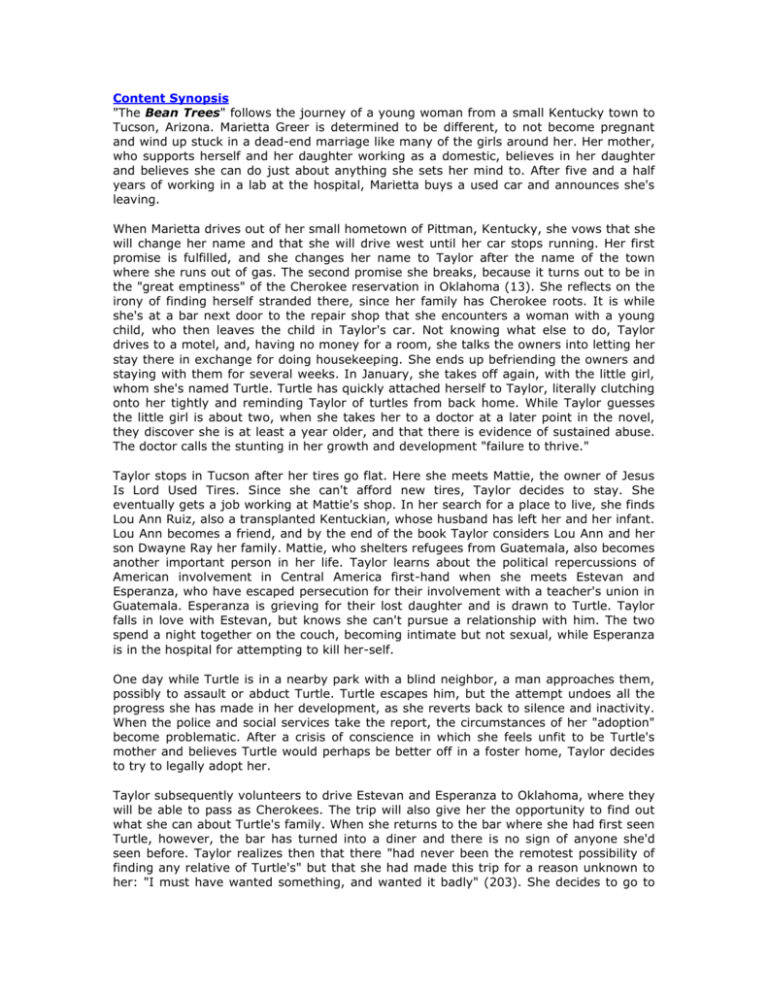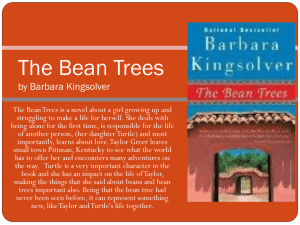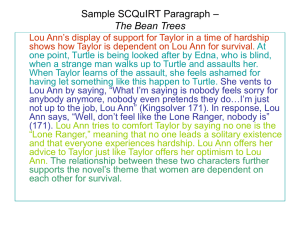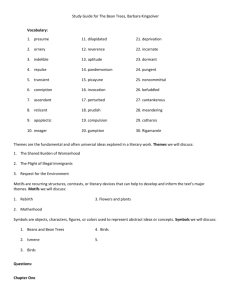Article 1 - Bean Trees.doc
advertisement

Content Synopsis "The Bean Trees" follows the journey of a young woman from a small Kentucky town to Tucson, Arizona. Marietta Greer is determined to be different, to not become pregnant and wind up stuck in a dead-end marriage like many of the girls around her. Her mother, who supports herself and her daughter working as a domestic, believes in her daughter and believes she can do just about anything she sets her mind to. After five and a half years of working in a lab at the hospital, Marietta buys a used car and announces she's leaving. When Marietta drives out of her small hometown of Pittman, Kentucky, she vows that she will change her name and that she will drive west until her car stops running. Her first promise is fulfilled, and she changes her name to Taylor after the name of the town where she runs out of gas. The second promise she breaks, because it turns out to be in the "great emptiness" of the Cherokee reservation in Oklahoma (13). She reflects on the irony of finding herself stranded there, since her family has Cherokee roots. It is while she's at a bar next door to the repair shop that she encounters a woman with a young child, who then leaves the child in Taylor's car. Not knowing what else to do, Taylor drives to a motel, and, having no money for a room, she talks the owners into letting her stay there in exchange for doing housekeeping. She ends up befriending the owners and staying with them for several weeks. In January, she takes off again, with the little girl, whom she's named Turtle. Turtle has quickly attached herself to Taylor, literally clutching onto her tightly and reminding Taylor of turtles from back home. While Taylor guesses the little girl is about two, when she takes her to a doctor at a later point in the novel, they discover she is at least a year older, and that there is evidence of sustained abuse. The doctor calls the stunting in her growth and development "failure to thrive." Taylor stops in Tucson after her tires go flat. Here she meets Mattie, the owner of Jesus Is Lord Used Tires. Since she can't afford new tires, Taylor decides to stay. She eventually gets a job working at Mattie's shop. In her search for a place to live, she finds Lou Ann Ruiz, also a transplanted Kentuckian, whose husband has left her and her infant. Lou Ann becomes a friend, and by the end of the book Taylor considers Lou Ann and her son Dwayne Ray her family. Mattie, who shelters refugees from Guatemala, also becomes another important person in her life. Taylor learns about the political repercussions of American involvement in Central America first-hand when she meets Estevan and Esperanza, who have escaped persecution for their involvement with a teacher's union in Guatemala. Esperanza is grieving for their lost daughter and is drawn to Turtle. Taylor falls in love with Estevan, but knows she can't pursue a relationship with him. The two spend a night together on the couch, becoming intimate but not sexual, while Esperanza is in the hospital for attempting to kill her-self. One day while Turtle is in a nearby park with a blind neighbor, a man approaches them, possibly to assault or abduct Turtle. Turtle escapes him, but the attempt undoes all the progress she has made in her development, as she reverts back to silence and inactivity. When the police and social services take the report, the circumstances of her "adoption" become problematic. After a crisis of conscience in which she feels unfit to be Turtle's mother and believes Turtle would perhaps be better off in a foster home, Taylor decides to try to legally adopt her. Taylor subsequently volunteers to drive Estevan and Esperanza to Oklahoma, where they will be able to pass as Cherokees. The trip will also give her the opportunity to find out what she can about Turtle's family. When she returns to the bar where she had first seen Turtle, however, the bar has turned into a diner and there is no sign of anyone she'd seen before. Taylor realizes then that there "had never been the remotest possibility of finding any relative of Turtle's" but that she had made this trip for a reason unknown to her: "I must have wanted something, and wanted it badly" (203). She decides to go to Lake o' the Cherokees, a scenic area on the reservation, without really knowing why. While they are there, Taylor connects Turtle's love of burying with her cries of "Mama" when she sees a cemetery. She asks Turtle if she'd seen her mother get buried, and Turtle affirms her suspicion. It is at that point that it is clear to Taylor that she is meant to keep Turtle. The next day Taylor goes to the office of a notary with Estevan and Esperanza, who pose as Turtle's parents giving her up for adoption. The papers are then filed for a "legal" adoption of Turtle. Taylor says good-bye to Estevan and Esperanza at a church, and she and Turtle head back to Tucson. The book's title refers to the recurring image of the bean tree, or wisteria plant, throughout the novel. As Taylor discovers at the end of the book, the plant is able to flourish in poor soil because of rhizobia, a microbe that nourishes its roots. The image underscores the importance of the mostly female community that nourishes Taylor and her adopted daughter. Historical Context "The Bean Trees" is set in the early 1980s and can be read as a critique of "the stonyheartedness of conservative bureaucrats [who] generated a selfishness and lack of compassion for the downtrodden" characterized by the Reagan era (Snodgrass 92). Turtle is given to Taylor when she is on the Cherokee reservation. The Cherokee was one of the so-called Five Civilized Tribes who was moved by the U.S. government from the southeastern United States to Oklahoma in the 1830s and 1840s. This trip, which resulted in many deaths and hardships, is often referred to as the Trail of Tears. Once the Cherokee and other tribes were established, however, "they prospered," building their own homes and schools and participating in the drafting of the state constitution ("People of Oklahoma" par. 3). The characters of Estevan and Esperanza, as well as the other refugees Mattie hides and helps to safety, represent real historical political refugees who were lucky enough to escape the brutal, repressive regimes of the time in Latin America. Kingsolver herself helped refugees from Chile, El Salvador and Guatemala in 1986 (Snodgrass 15). Estevan and Esperanza are Mayans from Guatemala, where at the time the non-democratic government was engaged in anti-insurgency campaigns that resulted in the destruction of Indian villages and the deaths of tens of thousands. ("Guatemala" 1) Societal Context A self-described political writer, Kingsolver addresses social issues on many fronts. Women's empowerment, class consciousness, political oppression, and racism all play roles to varying degrees in the novel. In her study of women's road narratives, critic Deborah Clarke compares "The Bean Tree" to Bobbie Ann Mason's "In Country" for its use of the automobile as marking a new symbolic connection to women's freedom in the 1980s. She notes that in the twentieth century, women's narratives opened up to include stories of travel, marking a move beyond traditional stories of house and home: "No longer relegated to waiting, women wrote increasingly about journeys, about mobility, and about the power inherent in this increased freedom. The motif of the journey, so long associated with men, from Odysseus to Sal Paradise, comes up more and more in women's texts." (Clarke par. 1) In "The Bean Trees," by presenting female characters such as Taylor, Taylor's mother, and Mattie, the car repair shop owner, Kingsolver "tweaks women's traditional roles without eradicating them." (Clarke, par. 30) This is because all three women take on the mother role while also displaying skills in handling car maintenance and repair, a traditionally male domain. Taylor's mother supports herself and her daughter and challenges her to learn how to maintain the used car Taylor has purchased. Mattie, the tire-shop owner, exhibits care- giving tendencies in her sheltering of Latin American refugees. Taylor, who eventually takes a job with Mattie, becomes a mother in the novel ironically as she is trying to escape the future of many of her peers in Kentucky of becoming "barefoot and pregnant" at a young age. In addition, the novel represents a departure from the historical and more popular convention of the happy marriage as ending; Taylor's love interest is married and remains faithful to his wife. Thus in the novel, despite its depiction of single motherhood and divorce, marriage and family remain sacrosanct. As a daughter of the working class from the socially stratified town of Pittman, Taylor is keenly aware of class divisions. She compares herself at the very beginning to the Hardbines, whose clan's father we first see being propelled into the air by an exploding tractor tire. At the same time as she clearly notes the differences between herself and them, she also is careful to acknowledge that she and Newt Hardbine were in the same class and that they were "cut out of basically the same mud" (2). Yet clearly Taylor as a young child has a sense of her own equality, since she insisted that she be called "Miss" Marietta as she "had to call all the people including the children in the houses where [her mother] worked Miss this or Mister that" (2). Later in the novel Taylor tells Estevan about Pittman and makes distinctions among the different groups: the town kids, whose parents were the business owners; the hoodlums (the "motorcycle types"); and the farm kids, also called the Nutters, because they would pick nuts. Estevan likens her description to the Indian caste system. A slightly less obvious comparison here is the oppression of the Mayans in Guatemala, which is represented by Estevan and Esperanza. Kingsolver, who was pregnant when she wrote the novel but did not experience life as a single mother, also addresses the struggles of poor, single mothers in the United States, struggles still very much relevant to readers twenty years later. In addition to Lou Ann, Taylor befriends another woman, Sandi, at a fast food restaurant. Sandi's strategy for handling childcare on minimum wage is to drop her child off at a free mall childcare center and to dash in on her breaks. Taylor rightly sees this as inadequate, especially for the already developmentally-delayed Turtle. By moving in with Lou Ann, Taylor finds an alternative arrangement by making a family of sorts, where Taylor and Lou Ann support each other, as an egalitarian married couple might, showing that building community is a vital activity for low-income families. Contrasts between urban and rural landscapes also reveal in a more subtle way Kingsolver's dedication to environmental concerns and to her sensitivity to the ways in which these landscapes shape communities. Taylor and Lou Ann live near a park that she nicknames "Dog Doo Park." Taylor describes it as "pretty awful. There were only a couple of shade trees, which had whole dead parts, and one good-for-nothing palm tree so skinny and tall that it threw its shade onto the roof of the cooler-pad factory down the block" (111). The grass reminds her of "an animal with mange" (111). The description reminds readers that parks in poor urban neighborhoods are subject to neglect and are often surrounded by industry. Still, it has its redeeming feature: wisteria, the bean tree plant. Taylor calls it "the Miracle of Dog Doo Park," thus reinforcing the theme of the novel. Dog Doo Park acts as a contrast to another park Taylor goes to, a "little hideaway by a stream" which they get to by car, a place described as having white rocks, clear water, and a ring of cottonwood trees. It is a place where Taylor and her friends bask in the sun, "feeling too good to move" (91). Such a place is nourishing to them, yet because it must be reached by car and then by a footpath, it is also less accessible. Religious Context Mary Ellen Snodgrass describes Kingsolver's religious outlook as "a homemade patchwork based on experience" and as infusing her fiction with "the human yearning for a faith suited to idiosyncratic needs" (172). Certainly Taylor seems to view religion, particularly a grassroots form of Christianity, in a humorous yet tolerantly respectful light. She gleefully observes when her car breaks down in Oklahoma that she's in the Cherokee nation, a place that connects her to a full-blooded Cherokee grandfather. One of the few things she seems to know about the Cherokee is that they "believed God was in trees" and that when she used to climb high up in trees her mother would tell her that she was "'trying to see God'" (13). This observation expresses her feeling of being different, foreshadowing her escape from Pittman and her own unique life path. The connections between religion and community are made clear through Lou Ann and the arrival of her baby. In the first chapter in which we meet Lou Ann, she is planning on a Catholic baptism for her baby, "purely for practical reasons; if one of the grandmothers was going to have a conniption, it might as well be the one who was eighteen hundred miles away" (28). After the baby is born, Granny Logan and Lou Ann's mother come to visit from Kentucky, creating more tension for Lou Ann. Lou Ann's mother continually hums one line of a hymn, "'All our sins and grief's to bear'," over and over until Lou Ann thought she would scream" (53). Granny Logan gives Lou Ann a bottle of water brought all the way from Kentucky in order to baptize the baby. Later, Lou Ann reacts to Granny's slur on her husband's Mexican ethnicity by muttering that she's prejudiced because he hadn't been baptized "in some old dirty crick" (59). Religion, then, is a cultural attachment, one that is shaken off when Lou Ann leaves behind Kentucky and her family. By contrast, Taylor's religious sensibility seems to be tied closely with her own unique take on the world. Faith is at issue, but religion becomes more of a metaphor for Taylor's own faith in herself. When she is in the bar next door to the repair shop in Oklahoma, she notices that someone on the television keeps saying, "Praise the Lord. 1-800-THE LORD." (17). This is the place where she first sees the woman with the child who will turn out to be Turtle. After the child is left in her car, Taylor wonders what she will do and tells the child that she may have to call 1-800-THE LORD (20). Instead she finds a motel where two women agree to let her stay in exchange for housekeeping work. The first contact with someone meaningful in Tucson is Mattie, the owner of Jesus Is Lord Used Tires. Taylor is partly attracted to the place because of its echo of the 1-800 phone numbers. Mattie is not who Taylor expects; after noticing that Mattie has a mug with cartoon rabbits fornicating on it she thinks, "I can't figure this woman out. This was definitely not 1-800- THE LORD" (41). Later, after Mattie announces that the Lord is sending a message for them to go to a desert oasis, she sums up Mattie's religious leanings as "just one damn thing after another" (91). At the end of the novel, Taylor actually calls the 800 number, on an impulse, even though she knows she doesn't "really need any ace in the hole" (226). A recording answers and tells her that "the Lord helps those that help themselves" and asks for a pledge to the Fountain of Faith missionary fund (226). When a woman comes on the line to take her pledge, Taylor thanks her for the number's existence, as it's been her own "Fountain of Faith." When the woman asks if she'd like to make a pledge, Taylor asks for money or a hot meal for herself. After she hangs up, she feels like doing cartwheels. Her joy can be interpreted as her satisfaction in succeeding in her struggles, from first finding herself the unwitting mother of a young child, to making a home in a new city. Just as the recording has indicated, she's helped herself. Kingsolver here turns religious rhetoric on its head by having the toll-free number stand in for any representation of a Jesus or God. The number, merely in its religious promise, is the one that represents faith, but when Taylor calls it, she finds it's only another organization asking for money, not one that will offer any real help for her. Perhaps, Kingsolver seems to say, it is through the self and community that real spiritual work is done. Scientific & Technological Context In her analysis of women's road narratives, Deborah Clarke observes the connections between the automobile, one of the most influential technological advances in the twentieth century, and women. Clarke notes that Taylor "drives a car that contains few of the advances of twentieth-century automobile technology such as windows and starters. In push-starting her car, she evokes the days of the crank engines, aligning herself with … intrepid women …who refused to let the necessary physical exertion keep them from the automobile "(Clarke, par. 28). The kind of relationship between a woman and her car that is depicted in "The Bean Trees" challenges assumptions about male power, which is often connected with almost-secretive knowledge and brute strength. The car is a particularly powerful symbol, in that it represents a person's ability to leave and go long distances easily and independently. Yet, as Clarke suggests, for Taylor the car becomes a domestic space; Turtle is left in the car and it acts as place for Taylor to sleep. As a trained scientist herself, Kingsolver can't help but include her own scientific knowledge in her writing. This knowledge is put to use through plant and animal imagery. As noted in the synopsis, the wisteria, or bean plant, is an important thematic tool in the novel. According to Mary Ellen Snodgrass, Kingsolver "makes use of the lowly bean as a double symbol of humility and of nature's building blocks." (50). Snodgrass notes that beans and plants in general, become an important teaching and communication tool for Taylor and Turtle. Turtle's language mainly consists of the names of plants; she is also especially interested in planting activities, which is later explained by Taylor's realization that she must have seen her mother be buried. In comparing Turtle's development to food such as corn, Kingsolver places human life "within the greater context of nature" (Snodgrass, 51). The night before Taylor plans to leave for Oklahoma with Turtle, Estevan, and Esperanza, her neighbor beckons her over to see the rare sight of the night-blooming cereus in full flower. Lou Ann calls it a good sign for their trip. The blooming of the cereus "seems by its loveliness to transform the world and people around it, and in predicting something good it foreshadows the knitting up of plot strands at the end of the novel" (DeMarr 6465). At another point in the novel, Kingsolver also adds an emotional depth to Taylor by depicting her response to the scene of a mother quail rounding up her babies in the road: "Something about the whole scene was trying to make tears come up in my eyes" (96). By showing her response to the quail, the author prevents the situation with Turtle from becoming too sentimental while also giving Taylor the emotional responsiveness of a mother. Other birds appear throughout the novel, in another, more subtle motif. In one scene, just after the frightening incident with Turtle in the park, Taylor busies herself in the kitchen with trying to free a bird trapped in the kitchen. In another more obvious scene, just after Taylor is told by the doctor that Turtle had been subjected to continual abuse that prevented her from growing, she marvels at a bird that has made a nest in a cactus. Biographical Context Barbara Kingsolver was born in 1955 in Annapolis, Maryland, but spent most of her childhood in the small town of Carlisle, Kentucky. Her father was a family physician; her mother is described as "an avid birdwatcher and true mountaineer in thought and accent" and "unorthodox" (Snodgrass, 7). She is the middle of three children. Growing up where she did supplied her with "her liberal, humanistic conscience, the moral compass of her writing" (Snodgrass, 8). Like Pittman, the fictional town where Taylor Greer is from, Carlisle was a small community whose agriculture was focused on tobacco. Here Kingsolver also witnessed the sharp divisions of class that Taylor describes in "The Bean Trees," divisions marked by the wealthy from Lexington and the poor from Appalachia. As the area's only doctor for thirty-six years, Dr. Wendell Kingsolver did not get rich in his practice, sometimes accepting vegetables for payment from his poor clients. As Kingsolver grew up, so did the awareness of her own poverty. According to Mary Ellen Snodgrass, her inability to afford new clothes "placed her in the local pecking order among country kids, a caste below the children of store owners, mine bosses, and county bureaucrats," a status that mirrors Taylor Greer's (10). From 1963 to 1966, Kingsolver's family lived in a small village in the central Congo, in western Africa, where her father had a public health post for two years. This was when the Congo had just achieved independence from Belgium; her experiences there form material for a later novel, "The Poisonwood Bible." Here, Kingsolver learned what it was like be a minority, taking away from the experience "an acutely heightened sense of race, of ethnicity," a sensibility that informs her characterization of Estevan and Esperanza in "The Bean Trees." (Kingsolver; qtd. in Snodgrass, 9) Kingsolver attended DePauw University on a music scholarship, but as a sophomore elected to pursue a B.S. in zoology and a minor in English. While there she was raped in 1974. Turtle could represent the innocence that she lost in the attack and an early attempt at coping with the memory of the trauma. (She would later write about the rape in her poetry and in an essay.) Kingsolver graduated with honors in 1977. In 1979, after spending some time in Europe, she drove from Carlisle, Kentucky to Tucson, Arizona, a trip that she fictionally depicts in "The Bean Trees." She has been living there ever since. In 1981, she earned an M.S. in animal behavior from the University of Arizona, thereafter working as a research assistant and technical writer. Kingsolver's training in biology is clearly evident in the novel, with its recurring images of plants and other natural phenomena. Pregnant with her first child and suffering bouts of insomnia, Kingsolver wrote her first novel, "The Bean Trees" in 1986. The book was published in 1988. "Pigs in Heaven" (1993), called a "non-sequel," continues the story of Taylor and Turtle, in which the consequences of Turtle's adoption cause more challenges for the little family. The author of nonfiction, poetry, and short stories, Kingsolver has published three other novels to date: "Animal Dreams" (1990), "The Poisonwood Bible" (1998), and "Prodigal Summer" (2000).






